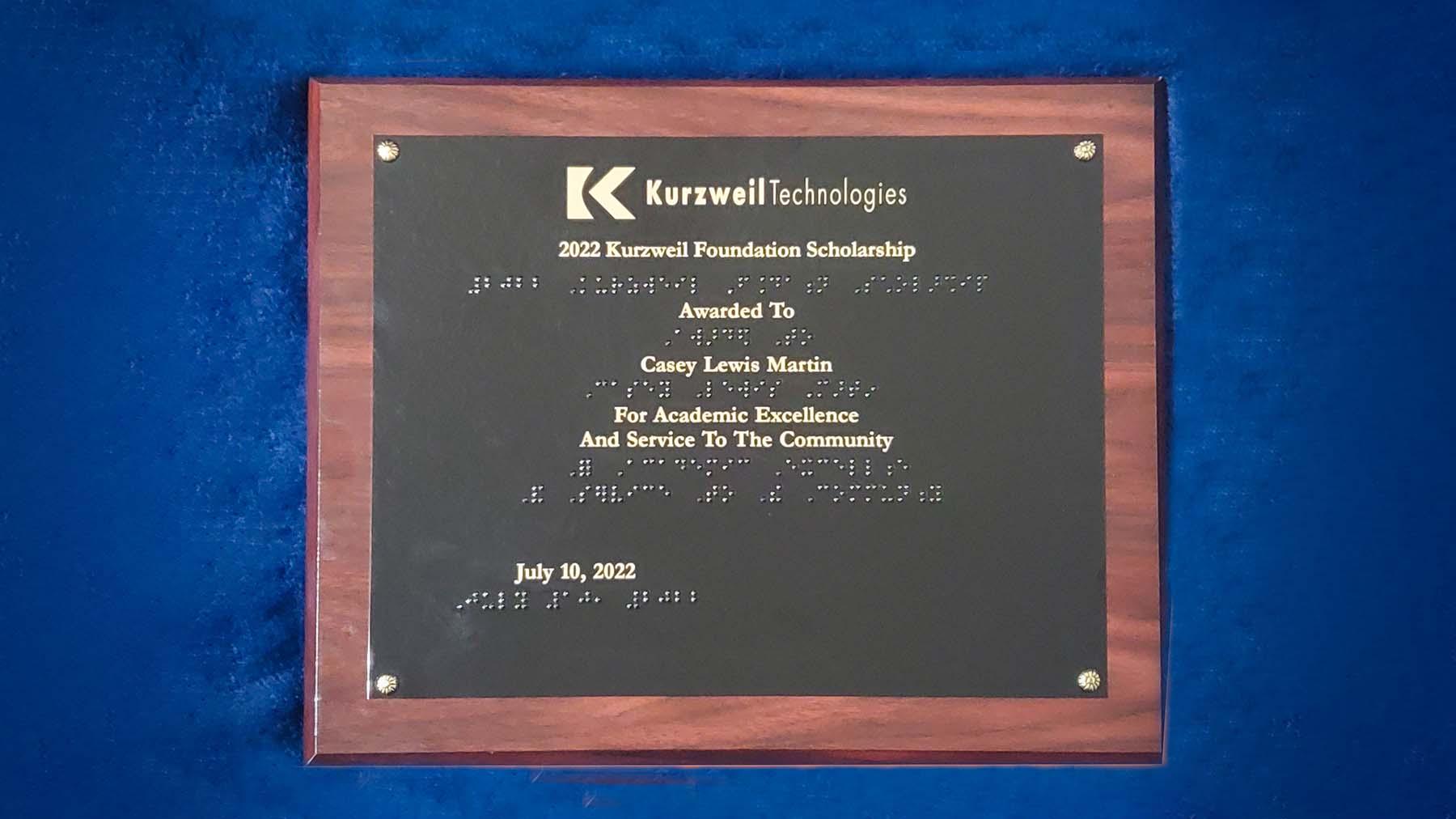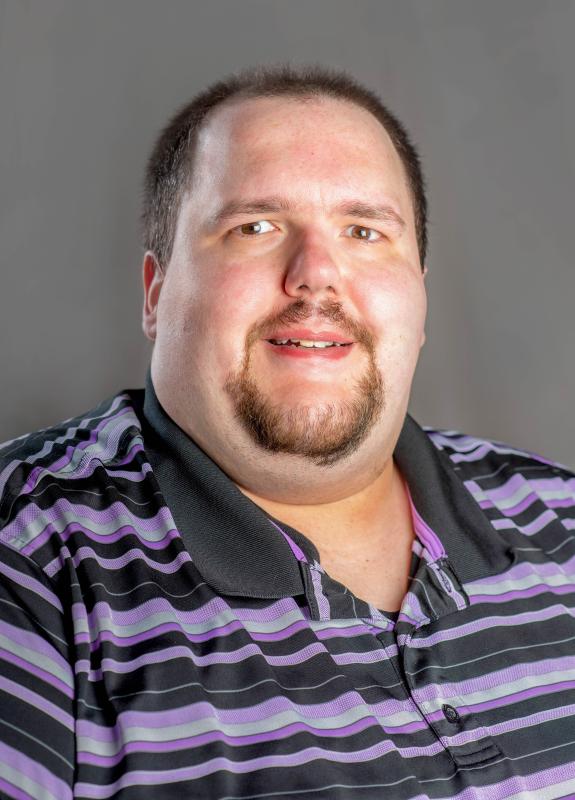Mary Grad Student Seeks to Become One of Select Few Legally Blind Speech-Language Pathologists in US

Casey Martin earns prestigious National Federation of the Blind (NFB) scholarship

BISMARCK, ND — When Casey Martin works with his patients at the University of Mary speech-language pathology (SLP) pro-bono clinic on campus, he sees them without color. Everyone, and everything, is a various shade of gray. Martin has Achromatopsia, a genetic condition that affects the cones of the retinas in his eyes: the cones are photoreceptors in the retina which respond differently to light of different wavelengths, and help people identify colors.
“As a result, I am completely color blind, legally blind, and live with photophobia, which is sensitivity to visual light,” explained Martin, a Valley City native who is a graduate student in Mary’s popular SLP program. “At present there is no known cure for this condition, however, its genetic roots are being studied. Although Achromatopsia presents a lot of challenges I have learned to utilize modern technologies to suit my needs, larger fonts for instance and electronic devices, the use of e-books for my studies instead of hardcopy textbooks etc. One of the biggest setbacks I currently face is that I am unable to drive. Transportation has and will continue to be a huge barrier in my life. I have always had to either rely on public transportation or someone else to help me with the smallest things that people without this kind of visual impairment can often take for granted, whether that be going to the store for groceries or to appointments, to school, or work.”
So, he admits, getting to work can be a challenge, but it’s what he accomplishes when he arrives at work that has earned him praise, confidence, and assistance from his professors and others. Martin utilizes every piece of adaptive technology — like an iPad — so he can better assess his patients.
“I participate in the same clinical experiences as the rest of the class, though sometimes in a slightly different manner,” added Martin. “I utilize adaptive technology to look inside a client’s mouth or a digital version of an assessment so I can enlarge the screen. As for the hands-on treatment, it has been exhilarating and rewarding to work with clients and see their progress throughout the semester.”
“We have provided Casey with monitors that swivel for improved access, as well as a user profile setting on a Windows system that is amenable for ameliorating existing access to visual information,” said Javad Anjum, assistant professor of SLP at the University of Mary and Martin’s advisor and mentor. “This is especially helpful, as accessibility features across the iPad and Windows systems allow him to complete academic and clinical work obligations without many hurdles. This is important as Casey is still required to meet the rigorous standards of the program, just as other students in the cohort. I find him to be a disciplined, intelligent, dedicated, and hardworking graduate student who is passionate about improving lives of people with disabilities, especially those with visual and communication impairments. Casey has also enriched our program by bringing in great diversity, experience, and interdisciplinary training — all of which he has already put to good use. Currently, we are working on a research project related to promoting awareness and advocacy for SLPs with disabilities working in the field.”
Martin’s research, with Anjum’s advising, targets the issue of disability as a component of diversity, equity, and inclusivity within the speech-language profession in terms of accessibility, accommodation, retention of speech-pathologists with physical disabilities, and advocacy for SLPs with disabilities.
According to Martin’s research, over the past 40 years, there have only been four legally blind SLPs in the US. To his knowledge, today, only one SLP still practices with visual impairments, and she lives in California.
Martin emphasized, “Interestingly, those with visual difficulties tend to have higher perceptual abilities when it comes to auditory processing and language. When it comes to practice, current data seems to back up the premise that someone with a visual deficit still observes more visually than they even recognize on a conscious and subconscious level. SLPs are incredibly important to those with varying degrees of disabilities and limitations. Communication is how we exhibit choice and connect with others and some of the most important aspects of improving quality of life. I want to be able to help people, everyday people, that struggle with being understood. My genetic condition has impacted my ability to see, it has restricted one of my senses, but I am succeeding. I want people, regardless of their disabilities, their limitations, or struggles, to push forward, to succeed and to thrive. If I can help just one person to tell their spouse or friend that they love them or that they appreciate them, or that they just want ice cream for dinner, then that is a world changed, and it will be worth it.”
For those accomplishments and more, Martin is one of only 30 across the nation to recently win an $8,000 scholarship from the National Federation of the Blind (NFB). NFB, the nation’s leading advocate for equal education for the blind, provides financial assistance and connects students with mentoring and other resources.
“The scholarship program is one of our most important initiatives,” said Mark A. Riccobono, president of the NFB. “We are proud to honor these blind scholars, each of whom are raising expectations and expanding possibilities. The accomplishments of these outstanding students are proof that we, the blind of this nation, can live the lives we want; blindness does not hold us back.”
With Martin’s insight into SLPs with disabilities, and the assistance of Anjum and Brittany Hernandez, director of clinical education and SLP at the University of Mary, they have put his research to use inside their own workspace.
“We have worked towards ensuring that our SLP graduate program is a thriving space for students with non-traditional and minority backgrounds, as well disabilities to get their SLP training,” added Anjum. “Where some universities and programs might have hesitated to offer admission to some of these students, we have boldly addressed the unique learning challenges these students bring in, as well as celebrated the amazing value they add to our program and to the campus community at the University of Mary.”
Martin who is 36, initially earned a political science degree in 2008, with the thought of later pursuing a law degree — a field where he could promote legislative change. Now, after many years of reflection between career changes, he is able to foster more change for good, daily, for those that struggle with being understood, just as he had hoped. When selecting an SLP graduate program, his ideals were a perfect match with the University of Mary and its values instilled by its founders — the Benedictine Sisters of Annunciation Monastery.
“Admittedly, coming here and not being Catholic was a worry for me, but Dr. Anjum and the other professors of the SLP Department have been amazing with respect to the Benedictine Values in their teachings. The Benedictine Values are parallel to what the National Federation of the Blind considers to be core values as well as the main principles of ethics. Leadership or servant leadership is critical, as well as respect for persons and their autonomy are fundamental to the University of Mary, Dr. Anjum, the NFB, and me. While it might be demonstrated in diverse ways, the core values are still there, and it made coming to the University of Mary so much easier than I anticipated. All the SLP professors and Dr. Anjum seek to instill in my classmates and I, a respect for the unique qualities and attributes that each person has to offer.”
And Martin has plenty to offer, even at a young age when people were telling him the things he couldn’t do, he proved them wrong. Martin was told as a child that he’d never be able to ride a bike, but with help from his loving parents and family members, he can ride a bike. And now, in a field where there is only one known legally blind SLP in the entire US, nobody would be able to tell he has a disability based on his skills and performance. However, he admits, people or patients may observe him holding materials very close to his face, wearing sunglasses wherever he goes indoors or outdoors, squinting, and one more clear giveaway.
“As an added joke to people or patients noticing, I would wager it is very seldom that my clothes match. I probably have worn some very clashing outfits so they might notice that,” added Martin, who is currently in the process of looking into externship opportunities at schools for the blind across the US.
Through Martin’s presence at Mary’s pro-bono clinic, his research, eventual full-time employment in the field, and the many obstacles he’s had to overcome with blindness, he’s breaking down the SLP barriers to education, training, and the profession’s work environments. As his research indicates, it is a feat very few have dared to conquer — until now.
Anyone who wishes to learn more about opportunities in speech language-pathology (SLP), can do so at www.umary.edu/SLP by contacting an admissions representative at enroll@umary.edu, or by calling (701) 355-8030. The University of Mary is one of only 15 Recommended Cardinal Newman Society Residential Colleges and Universities in the US.
About the University of Mary: True to its motto “lumen vitae” — The Light of Life — the University of Mary offers education for the whole of life through cutting-edge professional programs and graduate programs animated by moral courage and leadership in chosen professions and service to the community. A private, co-educational Catholic institution, the University of Mary welcomes students of all faiths and backgrounds.
A Christian, Catholic, Benedictine institution founded in 1959 by the Benedictine Sisters of Annunciation Monastery, Mary offers nearly 60 bachelor’s, 15 master’s, and five doctoral programs — in business administration, education, nursing practice, occupational therapy, and physical therapy. The 19-sport Athletic Department adheres to its Greatness Through Virtue mission under the governance of the National Collegiate Athletic Association (NCAA) and American Collegiate Hockey Association (ACHA) conferences. With more than 3,800 students, Mary has locations in North Dakota, Montana, Arizona, and Rome, Italy, as well as vibrant online offerings.
